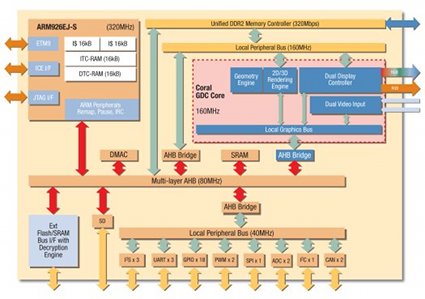ARM9 SoC gains lower-cost sibling
Mar 8, 2010 — by LinuxDevices Staff — from the LinuxDevices Archive — 1 viewsFujitsu announced an ARM9-based SoC (system on chip) including the company's “Coral PA” 2D/3D graphics controller. The MB86R03 “Jade L” is clocked at 320MHz, supports dual displays with resolutions up to 1024 x 768 pixels, and costs less than existing Jade SoCs, the company says.
Fujitsu's new MB86R03 "Jade L" is said to be aimed at "applications requiring high CPU performance combined with sophisticated 2D/3D graphics." Applications cited by the company include ATMs, HMI (human machine interface) panels, and automobiles.
According to Fujitsu, the Jade L has been reduced in cost compared to other members of its Jade family, "by keeping performance and quality equal … [while] offering peripherals selected for the target applications." In fact, the new SoC is not easy to distinguish from the previously released MB86R01 Jade.
Like the MB86R01, the MB86R03 comes in a 484-pin PBGA (plastic enhanced ball grid array) package, uses Fujitsu's 90nm process technology, and includes a 320MHz ARM926-EJS core. And again like the earlier part, the SoC features Jazelle Java acceleration, 16KB each of instruction and data cache, and a MMU (memory management unit, according to the company.

A block diagram of Fujitsu's MB86R03 Jade L
(Click to enlarge)
The MB86R03 also retains Fujitsu's "Coral PA" graphics processor, said to include a rendering engine for 2D/3D graphic acceleration functions, a geometry processor supporting floating point transformations for smooth graphics animation, and the ability to support dual independent displays. Potential resolutions range from 320 x 240 up to 1024 x 768 pixels, the company says.
Key graphics and video features are said to include:
- A texture mapping unit (up to 4096 x 4096)
- Bit-Blt unit (up to 4096 x 4096)
- Alpha Bit-Blt and ROP2 functions
- Six layers of overlay display (Windows)
- Alpha plane and constant alpha value for each layer
- Dual digital video input (various formats including YUV,RGB, ITU656)
- Video scaler (up/down scaling)
- Brightness, contrast and saturation control for video
- Built-in alpha blending, anti-aliasing and chroma-keying
According to Fujitsu, the MB86R03 has a unified DDR2 memory controller supporting up to 128MB of RAM at 320Mbps. Other onboard peripherals include a parallel flash/SRAM host interface with decryption engine, CAN, ADC, I2C, I2S, PWM, SPI, UART, GPIO, and an external interrupt, the company adds.
The above features match those previously cited for the MB86R01, so, as mentioned, it's not easy to ascertain how cost has been reduced. However, a comparison of block diagrams suggests that the MB86R03 drops the USB and parallel interfaces that were previously featured. (A block diagram for the earlier part may be found here.)
Availability
According to Fujitsu, the MB86R03 Jade-L supports Linux, Windows CE, Itron, QNX, and Wind River VxWorks. The SoC will begin sampling during the first quarter of this year, the company adds.
More information on the MB86R03 may be found on Fujitsu's website, here.
This article was originally published on LinuxDevices.com and has been donated to the open source community by QuinStreet Inc. Please visit LinuxToday.com for up-to-date news and articles about Linux and open source.